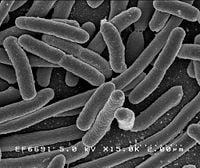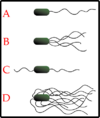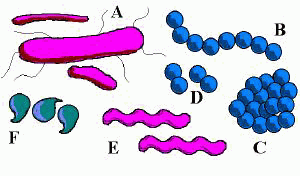Bacteria
| Bacteria | ||
|---|---|---|
 Escherichia coli (E. coli) | ||
| Scientific classification | ||
| ||
| Subgroups | ||
|
Actinobacteria |
Bacteria (singular: bacterium) are a group of microscopic, single-celled prokaryotesâthat is, organisms characterized by a lack of a nucleus or any other membrane-bound organelles.
Although among the most primitive organisms, bacteria reflect many universal features of life, including that they are composed of cells, transmit genetic information via DNA, and need energy from the environment to exist, grow, and reproduce; even sexual reproduction has been exhibited in some species of bacteria. Bacteria are often viewed negatively, given this group's connection to diseases. However, bacteria perform invaluable, beneficial functions in ecosystems, and also reflect harmony between living organisms in a number of ways. These include conversion of atmospheric nitrogen to forms that plants can use, exhibiting mutualism (a type of symbiosis in which both organisms in two interacting species receive benefit), and recycling nutrients through bacterial decomposition of dead plants and animals. Bacteria also provide an aid in digestion for many organisms, and are helpful in yogurt production, sewage treatment, and as sources of medicinal drugs.
Bacteria are the most abundant of all organisms. They are ubiquitous in both soil and water and as symbionts of other organisms. Many pathogens (disease-causing organisms) are bacteria. Most bacteria are minute, usually only 0.5-5.0 μm in their longest dimension, although giant bacteria like Thiomargarita namibiensis and Epulopiscium fishelsoni may grow past 0.5 mm in size. Bacteria generally have cell walls, like plant and fungal cells, but with a very different composition (peptidoglycans). Many move around using flagella, which are different in structure from the flagella of other groups.
Bacterial bodies may be spherical, rod-shaped, or spiral/curved shaped. Although unicellular, some bacteria form groupings of cells, such as clusters, filaments, or chains.
Taxonomy
The term "bacteria" has been variously applied to all prokaryotes, or to a major group of them exclusive of the anaerobic archaebacteria. In the five-kingdom system of classification (see taxonomy), bacteria are placed within the Kingdom Monera. In the three-domain system of classification, bacteria are usually considered synonymous with the Eubacteria or Bacteria domain, although the term sometimes includes the Archaea (originally labeled the Archaebacteria domain). The largely photosynthetic blue-green algae, or cyanobacteria, were once classified as algae, but are now considered bacteria. The study of bacteria is known as bacteriology, a subfield of microbiology.
Cellular structure
As prokaryotes, all bacteria have a relatively simple cell structure lacking either a cell nucleus or membrane-bound organelles such as mitochondria and chloroplasts. The DNA of prokaryotes floats freely inside the cell.
The most prominent bacterial structural characteristic is the cell wall. Bacteria can be divided into two groups (gram-positive and gram-negative) based on differences in cell wall structure as revealed by Gram staining. In a Gram stain, a series of dyes are applied to stain cell walls. Gram-negative bacteria have an outer, lipopolysaccharide-containing membrane and stain pink. They also have a thin peptidoglycan layer located in the periplasm (the region between the outer and cytoplasmic membranes). Gram-positive bacteria lack this covering, but possess a cell wall containing a thick peptidoglycan (called Murein in older sources) layer and teichoic acids; they stain purple. Gram-positive bacteria are more susceptible to antibiotics, while gram-negative bacteria are difficult to treat with antibiotics.
Many bacteria contain other extracellular structures such as flagella, fimbriae, and pili, which are used respectively for motility (movement), attachment, and conjugation (transmission of DNA between bacterial cells by contact other than fusion). Some bacteria also contain capsules or slime layers that facilitate bacterial attachment to surfaces and biofilm formation.
Bacteria contain relatively few intracellular structures compared to eukaryotes, but do contain a tightly supercoiled chromosome, ribosomes, and several other species-specific structures. These latter may include intracellular membranes, nutrient storage structures, gas vesicles, and magnetosomes (membranous organelles that contain magnetite crystals to orient magnetotactic bacteria in geomagnetic fields). Some bacteria are capable of forming endospores that allow them to survive extreme environmental and chemical stresses. This property is restricted to specific gram-positive organisms, such as Bacillus and Clostridium.
Reproduction
Bacteria reproduce through asexual reproduction (binary fission) that results in cell division. Two identical clone daughter cells are produced. Bacterial population growth is thus sometimes said to follow an approximate exponential growth phase.
Certain types of bacteria are also capable of sexual reproduction through bacterial conjugation. In conjugation, one bacterium ("plus") transfers genetic material to another ("minus") through a long, hollow tube called a sex pilus (plural: pili). The genetic material transferred may be either chromosomal or from a plasmid. Conjugation increases the genetic variability of bacterial populations and facilitates the emergence of antibiotic resistance.
Movement and senses
Motile bacteria can move about, either using flagella, bacterial gliding, or changes of buoyancy. A unique group of bacteria, the spirochaetes, have structures similar to flagella, called axial filaments, between two membranes in the periplasmic space. They have a distinctive helical body that twists about as it moves.
Bacterial flagella are arranged in many different ways. Bacteria can have a single polar flagellum at one end of a cell, clusters of many flagella at one end, or flagella scattered all over the cell, as with Peritrichous. Many bacteria (such as E. coli) have two distinct modes of movement: forward movement (swimming) and tumbling. The tumbling allows them to reorient and introduces an important element of randomness in their forward movement.
Motile bacteria are attracted or repelled by certain stimuli, and exhibit behaviors called taxisâfor instance, chemotaxis, phototaxis, mechanotaxis and magnetotaxis. In one distinctive group, the myxobacteria, individual bacteria attract each other to form swarms and may differentiate to form fruiting bodies. The myxobacteria move only when on solid surfaces, unlike E. coli, which is motile in liquid or solid media.
Some bacteria have the ability to âperceiveâ or sense the concentration gradient of stimuli to a resolution of one part per 10,000 (equivalent to a human being able to discern between two coin-filled jars, one filled with 9,999 coins, the other with 10,000).
Groups and identification
Historically, bacteria, as originally studied by botanists, were classified in the same way as plants, that is, mainly by shape. Bacteria come in a variety of different cell morphologies (shapes), including bacillus (rod-shape), coccus (spherical), spirillum (helical), and vibrio (curved bacillus). However, because of their small size, bacteria are relatively uniform in shape and therefore classification of species based on morphology was unsuccessful.
The first formal classification scheme originated following the development of the Gram stain by Hans Christian Gram. This separates bacteria based on the structural characteristics of their cell walls. This scheme included:
- GracilicutesâGram-negative staining bacteria with a second cell membrane
- FirmicutesâGram-positive staining bacteria with a thick peptidoglycan wall
- MollicutesâGram-negative staining bacteria with no cell wall or second membrane
- Mendosicutesâatypically staining strains now classified as cyanobacteria in the domain Archaea
Further developments essentially based on this scheme included comparisons of bacteria based on differences in cellular metabolism, as determined by a wide variety of specific tests. Bacteria were also classified based on differences in cellular chemical compounds such as fatty acids, pigments, and quinones. While these schemes allowed for the differentiation between bacterial strains, it was unclear whether these differences represented variation between distinct species or between strains of the same species. It was not until the utilization of genome-based techniques such as guanine+cytosine ratio determination, genome-genome hybridization, and gene sequencing (in particular the rRNA gene) that microbial taxonomy developed (or at least is developing) into a stable, accurate classification system. It should be noted, however, that due to the existence of numerous historical classification schemes and our current poor understanding of microbial diversity, bacterial taxonomy remains a changing and expanding field.
Bacteria that form clusters are described by the prefix staphylo, such as a cluster of spherical bacterial cells would be called a staphylococcus and a cluster of rod-shaped bacterial cells would be called a staphylobacillus. When bacteria form filaments, the prefix strepto is used, such that a cluster of rod-shaped bacterial cells would be called a streptobacillus.
History
Fossil bacteria have been found in deposits in present-day Australia that are estimated to be 3.5 billion years old. The great antiquity of the bacteria has enabled them to evolve a great deal of genetic diversity. They are far more diverse than the mammals or insects, for instance. Indeed, the genetic distance between E. coli and the bacterium Thermus aquaticus is greater than the genetic distance between humans and oak trees.
The first bacteria were observed by Anton van Leeuwenhoek in 1676 using a single-lens microscope of his own design. The name bacterium was introduced much later, by Christian Gottfried Ehrenberg in 1828, derived from the Greek word βακÏηÏιον meaning "small stick." Because of the difficulty in describing individual bacteria and the importance of their discovery to fields such as medicine, biochemistry, and geochemisty, the history of bacteria is generally described as the history of microbiology.
Two organelles of eukaryotesâmitochondria and chloroplastsâare generally theorized to have been derived from endosymbiotic bacteria.
Harmful and beneficial bacteria
Bacteria are the most numerous organisms on earth and are widely distributed on land and in the ocean, as well as carried by air currents from one place to another. While bacteria are ubiquitous, they concentrate where they have food, moisture, and the right temperature for their multiplication and growth. The human body is home to billions of microorganisms; they can be found on skin surfaces, in the intestinal tract, in the mouth, nose, and other body openings. They are in the air one breathes, the water one drinks, and the food one eats.
Bacteria are often noted for their role in disease and infection in humans. Some bacteria act as pathogens and cause tetanus, typhoid fever, pneumonia, syphilis, cholera, food-borne illness, leprosy, and tuberculosis (TB). Hundreds of thousands of people die every year from bacterial infections. In the fourteenth century, millions of poepleâmore than half the population of Europeâwere killed by the bubonic plague, caused by a rod-shaped bacteria transmited by flea bites and spread by mice and rats. The bubonic plague still exists today, although it is treatable with antibiotics. Sepsis, a systemic infectious syndrome characterized by shock and massive vasodilation, or localized infection, can be caused by bacteria such as Streptococcus, Staphylococcus, or many gram-negative bacteria. Some bacterial infections can spread throughout the host's body and become systemic.
The mode of infection by bacteria includes via contact, air, food, water, and insect-borne microorganisms. The hosts infected with the pathogens may be treated with antibiotics, which can be classified as bacteriocidal (kills bacterial) and bacteriostatic (slows bacterial growth and reproduction). Antiseptic measures may be taken to prevent infection by bacteria, for example, swabbing skin with alcohol prior to cutting the skin during surgery or when piercing the skin with the needle of a syringe. Sterilization of surgical and dental instruments is done to make them sterile or pathogen-free to prevent contamination and infection by bacteria. Sanitizers and disinfectants are used to kill bacteria or other pathogens to prevent contamination and risk of infection.
Bacteria are responsible for some diseases in livestock. Anthrax is a deadly bacteria that infects cattle and sheep. Salmonella is a cause of intestinal infection in calves, and mastitis is an infection of cow udders caused by bacteria. Some bacteria may attack the cells directly, while others produce substances that are toxic to the animals.
Bacterial infection is not limited to animals. In plants, bacteria cause leaf spot, fire blight, and wilts. Sometimes bacteria cause soft rots in plants, whereby the tissue becomes a slimy mess. Pea blight is caused by a bacterium, as is fire blight of apples and pears.
Despite these harmful effects, bacteria offer innumerable, important benefits to the environment, plants, and animals, including humans.
A key function of bacteria in the ecosystem is in decomposition of living matter. As decomposers, bacteria feed on the tissues of dead organisms, breaking them down into nitrogen- and carbon-containing molecules. What they do not use as food can then be used by plants as nutrients. Indeed, one can view bacteria as key to both the beginning and end of the food chain, as they provide necessary nutrients for the start of the food chain and also breakdown the organic matter at the end of the food chain.
Some bacteria, including E. coli, help people and animals to digest food and help in providing vitamins. Ruminants, such as cattle and sheep, contain large numbers of bacteria in the rumen to help in digestion of grass by the degrading cellulose into nutrients that can be absorbed. Ruminants rely on the bacteria, since they lack these essential digestive enzymes themselves.
The ability of bacteria to degrade a variety of organic compounds is remarkable. Highly specialized groups of microorganisms play important roles in the mineralization of specific classes of organic compounds. The decomposition of cellulose, which is one of the most abundant constituents of plant tissues, is mainly brought about by aerobic bacteria that belong to the genus Cytophaga. Bacteria capable of digesting the hydrocarbons in petroleum are often used to clean up oil spills. Some beaches in Prince William Sound were fertilized in an attempt to facilitate the growth of such bacteria after the infamous 1989 Exxon Valdez oil spill. These efforts were effective on beaches that were not too thickly covered in oil. In treatment of sewage and farm wastes, bacteria break down organic matter so it does not pollute the environment.
Beyond organic matter, bacteria can also degrade metal cyanides from industrial sites, help in cleaning up nuclear waste, recover metal from low-grade ores, and degrade some pesticides.
Bacteria are key for nitrogen fixation. Plants require nitrogen to build protein, but cannot use atmospheric nitrogen directly, despite its high concentration in the air (78 percent). In soil and even plant roots, nitrogen-fixing bacteria help convert nitrogen into a usable form, such as nitrates and ammonia, by a process known as nitrogen fixation. This serves to provide an easily absorbable form of nitrogen for many plants. For example, in legume plants, such as peas and clover, microorganisms (rhizobia) help in the transformation of molecular dinitrogen gas, converting it to usable nitrogenous compounds.
Bacteria, often in combination with yeasts and molds, are used in the preparation of fermented foods such as cheese, pickles, soy sauce, sauerkraut, vinegar, wine, and yogurt. Using biotechnology techniques, bacteria can be bioengineered for the production of therapeutic drugs, such as insulin, or for the bioremediation of toxic wastes.
ReferencesISBN links support NWE through referral fees
- Alcamo, I. E. 1997. Fundamentals of Microbiology. 5th ed. Menlo Park, California: Benjamin Cumming.
- Atlas, R. M. 1995. Principles of Microbiology. St. Louis, Missouri: Mosby.
- Holt, J. G. 1994. Bergey's Manual of Determinative Bacteriology, 9th edition. Baltimore, Maryland: Williams and Wilkins.
- Hugenholtz, P., B. M. Goebel, and N. R. Pace. 1998. Impact of culture-independent studies on the emerging phylogenetic view of bacterial diversity. Journal of Bacteriology 180 (18): 4765-74.
- Koshland, D. E. 1977. A response regulator model in a simple sensory system. Science 196: 1055-1063.
- Stanier, R. Y., J. L. Ingraham, M. L. Wheelis, and P. R. Painter. 1986. General Microbiology, 5th edition. Upper Saddle River, NJ: Prentice Hall.
- This article contains material from the Science Primer published by the NCBI, which, as a US government publication, is in the public domain at http://www.ncbi.nlm.nih.gov/About/disclaimer.html.
Credits
New World Encyclopedia writers and editors rewrote and completed the Wikipedia article in accordance with New World Encyclopedia standards. This article abides by terms of the Creative Commons CC-by-sa 3.0 License (CC-by-sa), which may be used and disseminated with proper attribution. Credit is due under the terms of this license that can reference both the New World Encyclopedia contributors and the selfless volunteer contributors of the Wikimedia Foundation. To cite this article click here for a list of acceptable citing formats.The history of earlier contributions by wikipedians is accessible to researchers here:
The history of this article since it was imported to New World Encyclopedia:
Note: Some restrictions may apply to use of individual images which are separately licensed.
Some text in the original Wikipedia article was merged with the Nupedia article entitled Bacteria, which was also a free content encyclopedia, using a GNU Free Documentation License.

